In a car battery, the positive terminal is usually larger, marked with a “+” symbol, and often has a red cable connected to it. The negative terminal is smaller, marked with a “-” symbol, and typically has a black cable. Always check markings to avoid confusion.
I’m your friendly neighborhood battery expert, and boy, do I have some electrifying information for you today. You see, I’ve spent years, yes years, diving deep into the world of batteries, and I’ve learned a thing or two that might just spark your interest.
Today, we’re going to talk about car batteries, those little powerhouses that get your engine revving and your radio blasting. Now, you might think a battery is just a battery, but oh, my friend, there’s so much more to it. From the chemical reactions that make your headlights shine to the importance of knowing your positive from your negative terminals, there’s a world of knowledge to uncover.
So buckle up, because we’re about to embark on a journey into the heart of your car’s electrical system. Trust me, it’s going to be a positively charged adventure!
What is a Car Battery?

Well, let’s dive right into the heart of the matter, shall we? A car battery, my friends, is more than just a box sitting in your vehicle. It’s a marvel of chemical reactions and electrical energy, and it’s what gives your car the juice to start and run.
A car battery is made up of an anode, cathode, separator, electrolyte, and two current collectors (positive and negative). The anode and cathode store the lithium. The electrolyte carries positively charged lithium ions from the anode to the cathode and vice versa through the separator.
This movement of lithium ions creates free electrons in the anode, which creates a charge at the positive current collector. The electrical current then flows from the current collector through a device being powered (like your car’s engine or radio) to the negative current collector. The separator blocks the flow of electrons inside the battery.
Now, when the battery is discharging and providing an electric current, the anode releases lithium ions to the cathode, generating a flow of electrons from one side to the other. But when you plug in your car to charge, the opposite happens: Lithium ions are released by the cathode and received by the anode.
How to Identify the Positive and Negative Sides of a Car Battery?
Now that we’ve got the science out of the way, let’s get practical. If you’ve ever found yourself staring at a car battery, scratching your head, and wondering which terminal is which, you’re not alone. But don’t worry, I’ve got your back.
Symbols on a Car Battery
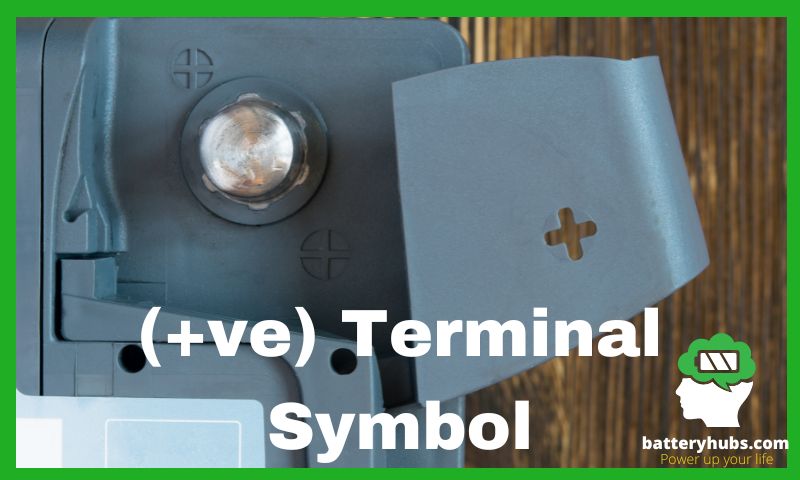
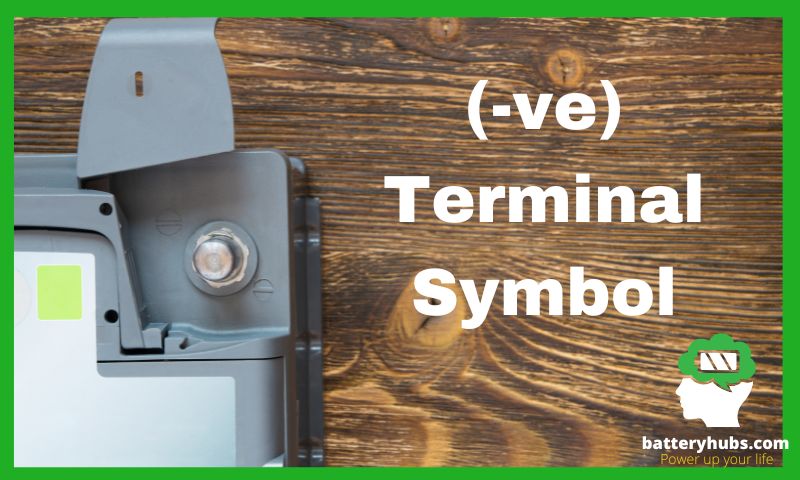
First things first, let’s talk symbols. On a car battery, you’ll typically see a ‘+’ and a ‘-‘ symbol. These aren’t just for show, folks. The ‘+’ symbol represents the positive terminal, and the ‘-‘ symbol represents the negative terminal. Simple, right?
Color Coding System
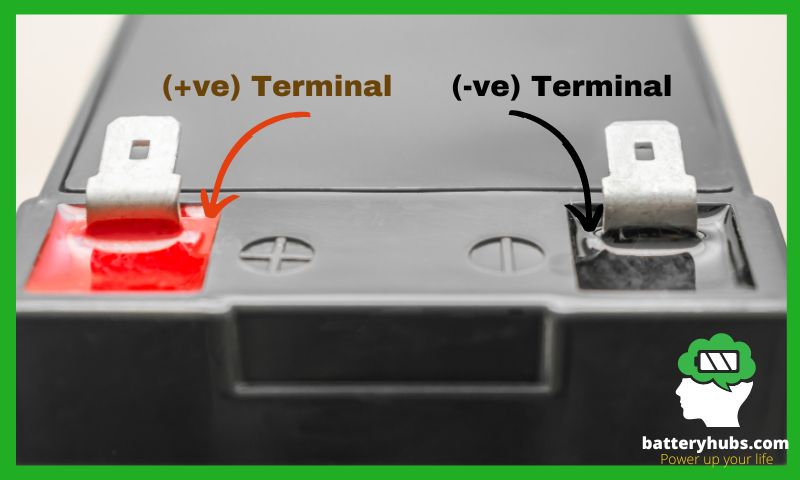
But wait, there’s more! Car batteries also use a color-coding system. The positive terminal is usually covered with a red cap or it’s near a red cable, while the negative terminal is typically associated with black. So, if you’re ever in doubt, just remember: “Red is positive, black is negative.”
Size Difference Between the Terminals
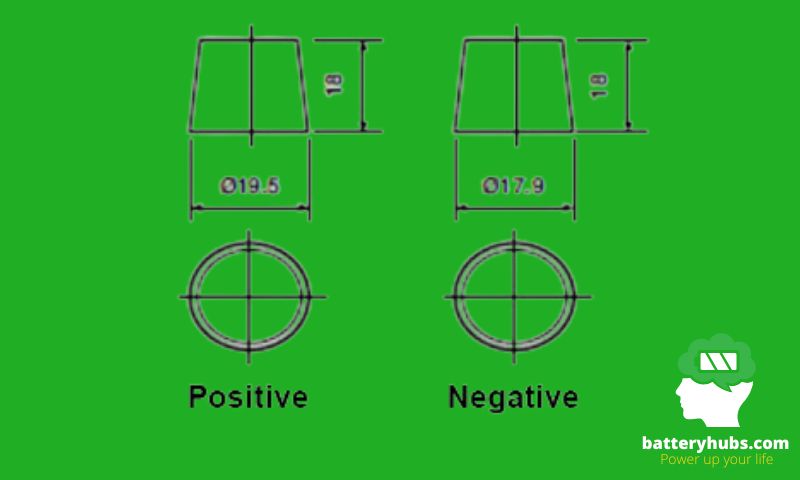
And here’s a fun fact: the positive and negative terminals are different sizes. The positive terminal is slightly larger than the negative terminal. This is a safety feature designed to prevent the wrong cables from being connected to the wrong terminals. So, if you’re trying to connect a cable and it’s not fitting quite right, you might want to double-check that you’ve got the right terminal.
Battery terminal size is an essential characteristic to consider when replacing or purchasing a car battery. The T1 and T3 terminal types are two commonly used car battery terminals. The distinction between the two primarily lies in their widths.
The T1, also known as a DIN type terminal, is a standard in European cars and is prevalent in most UK vehicles. This terminal is tapered and wider at the base. To prevent the risk of reversing the connectors and fitting incorrectly, the positive terminal measures 19.5mm in diameter, and the negative terminal is slightly narrower at 17.9mm.
On the other hand, the T3 terminal, also referred to as a JIS type terminal, is often found in Japanese vehicles, particularly imports. Like the T1, the T3 terminal design also intends to prevent incorrect fitting with the positive terminal being wider than the negative. However, the diameters are smaller, with the positive terminal measuring 14.7mm and the negative terminal measuring 13.1mm.
Choosing the right terminal size for your vehicle is crucial for the proper functioning of your car’s electrical system. To select the suitable battery for your vehicle, you can use tools such as the “Search by Numberplate” function or seek advice from experts. MDS Battery, for instance, provides customer assistance with the correct selection of automotive batteries.
Keep in mind that the terminal size is just one factor to consider when choosing a car battery. Other factors, such as battery type, capacity, and voltage, should also be considered to ensure the battery fits your car’s requirements.
What Happens if You Connect the Wrong Cables to a Car Battery?
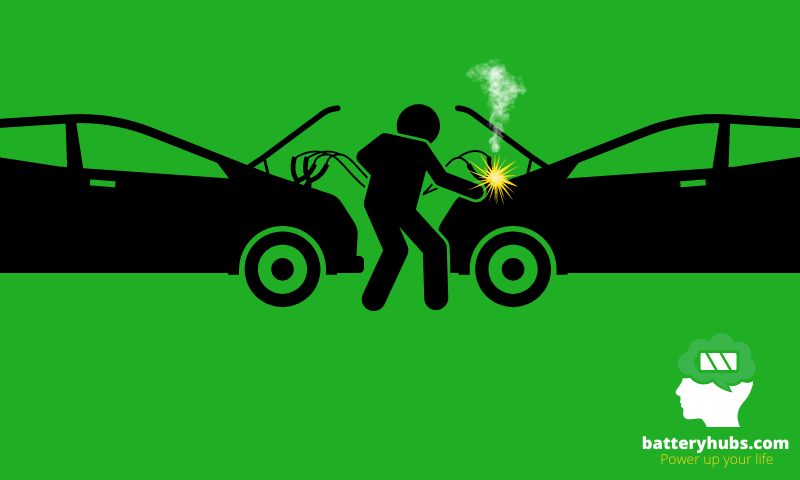
Alright, folks, it’s time for a little heart-to-heart. You see, in my many years of battery expertise, I’ve seen some things. Things that would make your hair stand on end. And one of the most common, and potentially dangerous, mistakes I’ve seen is connecting the wrong cables to a car battery. So, let’s talk about what happens when you mix up those cables, and why it’s so important to get it right.
Potential Dangers and Damages
Now, I’m not one to scaremonger, but I’ve got to tell you, connecting the wrong cables to a car battery is no laughing matter. If you connect the positive cable to the negative terminal and vice versa, you’re in for a world of trouble.
We’re talking sparks, smoke, and even fire. And that’s not even the worst of it. This kind of mistake can cause serious damage to your car’s electrical system, potentially costing you a pretty penny in repairs.
| Potential Dangers | Potential Damages |
|---|---|
| Sparks | Damage to the car’s electrical system |
| Smoke | Costly repairs |
| Fire | Damage to the battery itself |
Importance of Correct Cable Connection
So, why is it so important to connect the right cables to the right terminals? Well, in a nutshell, your car’s electrical system is a finely tuned machine. It relies on the correct flow of electricity from the battery to function properly. When you mix up the cables, you disrupt that flow, causing all sorts of chaos.
Connecting the cables correctly ensures that your car starts properly, your lights shine brightly, and your radio keeps playing your favorite tunes. So, remember, folks: red to positive, black to negative. It’s a simple rule, but it can save you a whole lot of trouble.
So, the next time you’re under the hood of your car, take a moment to double-check those cables. Your car (and your wallet) will thank you!
How to Safely Jumpstart a Car?
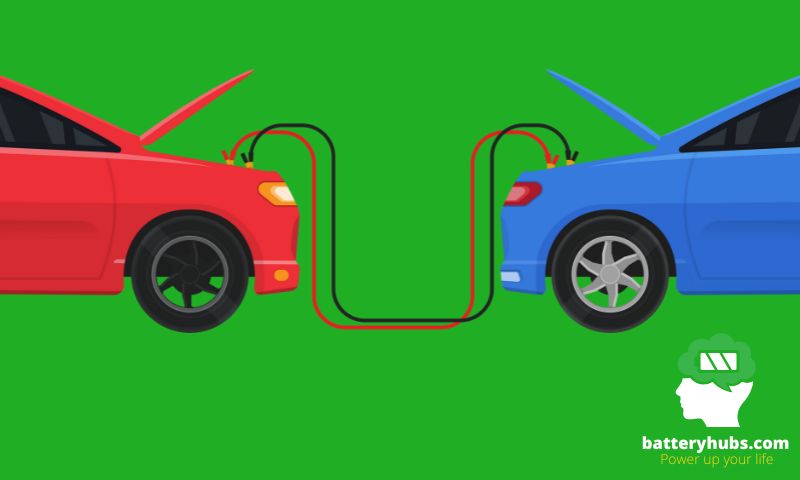
Alright, my friends, it’s time to roll up our sleeves and get down to business. You see, in my many years in the battery biz, I’ve jumpstarted more cars than I can count. And let me tell you, there’s a right way and a wrong way to do it. So, let’s walk through the steps together, shall we?
Step-by-Step Guide on How to Safely Jumpstart a Car
Step-01: Safety First
Before we start, make sure both cars are off, and the keys are out of the ignition. Safety goggles and gloves aren’t a bad idea either. Remember, we’re dealing with electricity here.
Step-02: Position the Cars
Position the cars so the batteries are within reach of the jumper cables, but make sure the cars aren’t touching.
Step-03: Connect the Cables
Now, grab your jumper cables. Connect one red clamp to the positive terminal of the dead battery, and the other red clamp to the positive terminal of the good battery.
Step-04: More Connections
Next, connect one black clamp to the negative terminal of the good battery. The other black clamp should be connected to an unpainted metal surface on the car with the dead battery. This is called grounding, and it’s a crucial step in the process.
Step-05: Start Your Engines
Start the car with a good battery and let it run for a few minutes. Then, try starting the car with the dead battery.
Step-06: Disconnect the Cables
Once the car with the dead battery is running, you can disconnect the cables. Start with the black clamps, then the red.
Step-07: Keep it Running
Keep the jumpstarted car running for at least 15 minutes to recharge the battery.
Importance of Connecting the Correct Cables to the Correct Terminals
Now, you might be wondering why we’re so particular about connecting the right cables to the right terminals. Well, as we discussed earlier, connecting the cables incorrectly can cause sparks, smoke, and even fire. Not exactly the kind of excitement we’re looking for, right?
So, remember, when it comes to jumpstarting a car, always connect red to positive and black to negative. It’s a simple rule, but it can make all the difference between a successful jumpstart and a potential disaster.
Signs of a Dead Car Battery
Now, let’s talk about something that’s as inevitable as taxes – a dying car battery. It’s a fact of life, folks. No battery lasts forever, and it’s important to know the signs that your car battery is on its last legs.
List of Common Signs That a Car Battery Needs Replacing
- Slow Engine Crank: When you attempt to start the vehicle, the cranking of the engine is sluggish and takes longer than normal to start.
- Check Engine Light: The check engine light sometimes appears when your battery power is weak.
- Low Battery Fluid Level: Car batteries typically have a part of the casing that’s translucent so you can always keep an eye on your battery’s fluid level.
- Swelling, Bloating Battery Case: If your battery casing looks like it ate a very large meal, this could indicate a battery gone bad.
- Battery Leak: Leaking also causes the corrosion around the posts (where the “+” and “–” cable connections are located.)
- Old Age: Your battery can last well beyond three years but, at the very least, have its current condition inspected on a yearly basis when it reaches the three-year mark.
Explanation of Each Sign and What It Means
Slow Engine Crank: This is often the first sign of trouble. It means your battery doesn’t have enough power to turn the engine over, and it’s time for a replacement.
Check Engine Light: This light can mean a lot of things, but if it comes on along with some of these other symptoms, it could very well mean a dying battery.
Low Battery Fluid Level: If the fluid level is below the lead plates (energy conductor) inside, it’s time to have the battery and charging system tested.
Swelling, Bloating Battery Case: Extreme heat can cause the battery case to swell, decrease your battery life and cause your battery to die.
Battery Leak: This can lead to corrosion around the posts, where the positive and negative cable connections are located. The gunk may need to be removed; otherwise, your car may not start.
Old Age: If your battery is old or weak, your car may not start in cold weather even if there are no visible signs of a dead battery.
Remember, folks, it’s always better to be safe than sorry. If you notice any of these signs, it’s a good idea to have your battery checked out by a professional. After all, the last thing you want is to be stranded on the side of the road with a dead battery. Trust me, I’ve been there, and it’s not fun!
| Signs of a Dead Car Battery | Explanation |
|---|---|
| Slow Engine Crank | The engine cranks slowly and takes longer than normal to start, indicating the battery doesn’t have enough power. |
| Check Engine Light | The light can indicate various issues, including a weak battery, especially if it appears with other symptoms. |
| Low Battery Fluid Level | If the fluid level is below the lead plates inside the battery, it’s time to have the battery and charging system tested. |
| Swelling, Bloating Battery Case | Extreme heat can cause the battery case to swell, reducing battery life and leading to battery failure. |
| Battery Leak | Leaking can lead to corrosion around the posts, where the positive and negative cable connections are located. The gunk may need to be removed; otherwise, your car may not start. |
| Old Age | If your battery is old or weak, your car may not start in cold weather even if there are no visible signs of a dead battery. |
Conclusion
Well, folks, we’ve been on quite a journey together, haven’t we? We’ve delved into the depths of car batteries, learned how to identify positive and negative terminals, and even discovered how to jumpstart a car. We’ve also talked about the signs of a dying battery and why it’s so important to keep an eye on them.
Remember, your car battery is the heart of your vehicle’s electrical system. It powers everything from your headlights to your radio, and without it, you’re not going anywhere. So, take care of your battery, and it’ll take care of you.
As we wrap up, I want to remind you that understanding your car battery is just the tip of the iceberg when it comes to the fascinating world of batteries. There’s so much more to learn and explore. For instance, have you ever wondered how a battery works in a circuit? Or maybe you’re curious about how a rechargeable battery gets recharged?
Perhaps you’re interested in the environmental impact of batteries or want to dive into a battery chemistry comparison. Maybe you’re looking for some practical battery maintenance and care tips or want to learn about the top battery manufacturers and brands.
Whatever your battery-related questions or interests, our website is a treasure trove of information. So, why not take a moment to explore? You might just find yourself becoming a battery expert too!
And remember, whether you’re jumpstarting a car or simply changing the batteries in your remote, always handle batteries with care. They’re small but mighty, and they deserve our respect. So, here’s to you, batteries – the unsung heroes of our modern world!
FAQs
Q: Is it positive red or black on a car battery?
A: On a car battery, the positive terminal is typically marked with a plus sign (+) and is usually covered by a red cap or features red cables. The negative terminal, on the other hand, is marked with a minus sign (-) and typically has black cables. So, yes, positive is red on a car battery.
Q: Where does the positive cable go on a car battery?
A: The positive cable should be connected to the positive terminal of the car battery. This terminal is usually marked with a plus sign (+) and is often covered by a red cap or connected to red cables.
Q: Does it matter which battery terminal I connect to first?
A: Yes, it does matter. When connecting a car battery, you should always connect the positive terminal first. This is typically the red cable or the terminal marked with a plus sign (+). After the positive terminal is connected, you can then connect the negative terminal.
Q: What happens if you connect the negative terminal first?
A: Connecting the negative terminal first can cause a spark, which could ignite any flammable vapors around the battery. This could potentially cause an explosion. Therefore, it’s always safer to connect the positive terminal first.
Q: Can a car battery explode if connected wrong?
A: Yes, a car battery can potentially explode if the cables are connected to the wrong terminals. This can cause a spark which could ignite the hydrogen gas that batteries emit, leading to an explosion. It’s crucial to connect the red cable to the positive terminal and the black cable to the negative terminal to avoid such a situation.
Q: How do I know if my car battery is fully charged?
A: A fully charged car battery should register at around 12.6 volts or higher. If your battery is not fully charged, the voltage will be lower. You can check this using a multimeter. If you don’t have a multimeter, your car’s performance may also indicate the battery’s charge level. For instance, if your car is slow to start, it might mean your battery is not fully charged.
